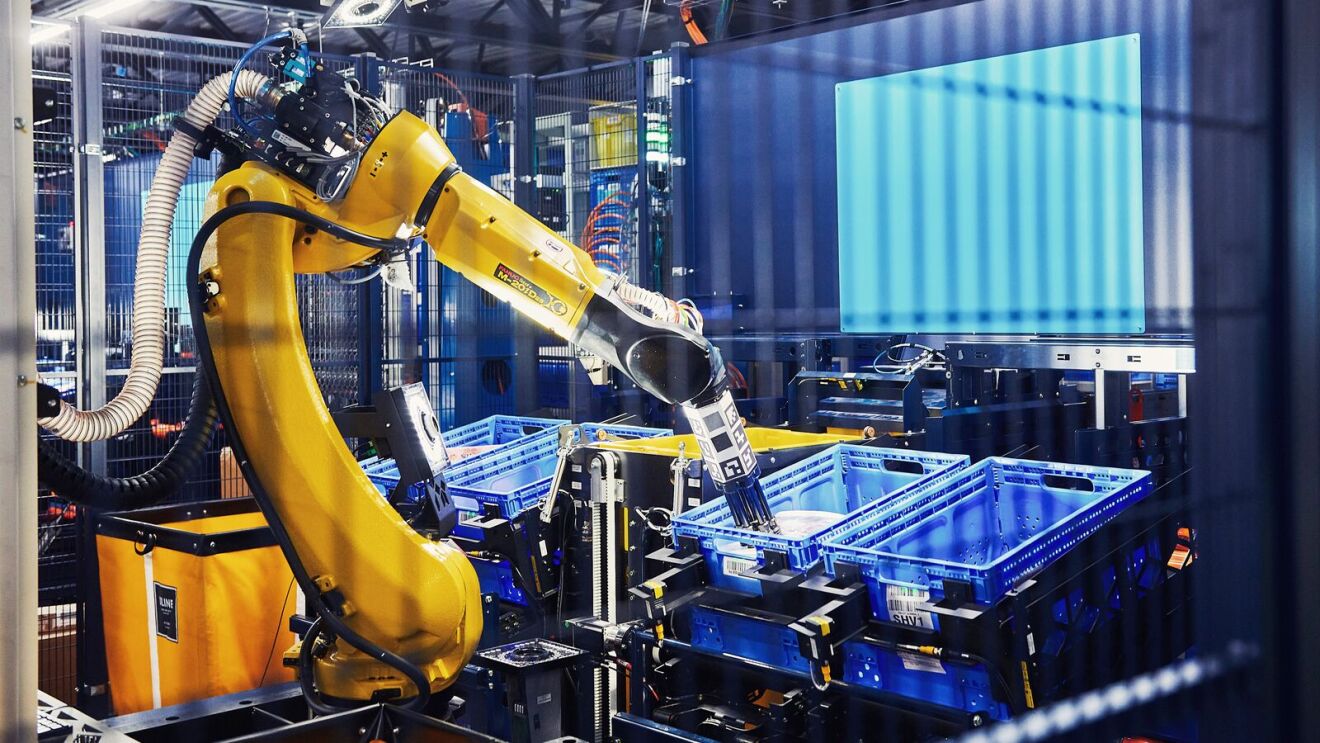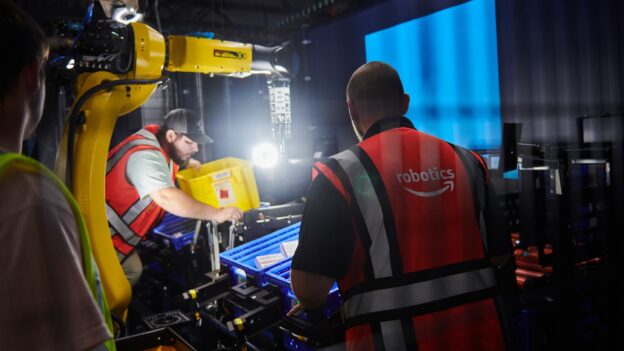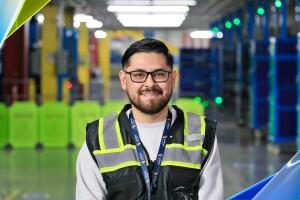Learn how Amazon maintains its edge in robotics by focusing on real-world impact and transformative AI technologies.
Amazon’s vice president of Fulfillment Technology and Robotics, Joseph Quinlivan, leads a team of employees that has designed, manufactured, and deployed the world’s largest fleet of more than 750,000 industrial robots.
These robots work collaboratively with operations employees to help deliver packages to customers around the world. A decade after Amazon’s ramp-up in the use of robotics across its fulfillment operations, Quinlivan’s team remains relentlessly focused on improving the employee and customer experience through technology, always asking “why” in everything we build.
 Amazon’s vice president of Fulfillment Technology and Robotics, Joseph Quinlivan
Amazon’s vice president of Fulfillment Technology and Robotics, Joseph QuinlivanHere are five lessons Quinlivan shared in an internal Q&A about how to sustain an innovation culture at Amazon.
1. Physical AI is about to change everything in robotics. Innovation requires us to always be at the cutting edge.
“Staying at the cutting edge of robotics requires relentless focus on building practical and impactful systems we can with today’s state-of-the-art technology, while simultaneously driving long-term research and bold experimentation. At Amazon, we don’t build technology for the sake of it. We develop technology that drives real-world impact at scale, improving operational safety, creating higher skilled roles for Ops employees, and continuously improving workplace so our teams can better deliver for customers.
“To sustain innovation in such a fast-moving field, we must invest heavily in what will be the next generation of robotics and now, more than ever, that includes AI. Our teams are leading key advancements in robot autonomy, manipulation, sortation, and computer vision, harnessing the latest in AI to enable robots to better perceive, adapt, and collaborate with employees in dynamic environments. We are also driving cross-disciplinary breakthroughs, such as the convergence of generative and agentic AI in physical robotics, unlocking even more intelligent and capable systems.”

2. Always build technology that drives real-world impact at scale.
“This will come as no surprise to anyone, but the future of robotics and AI is evolving rapidly, and it’s critical to stay at the forefront of this transformation.
“One key area of advancement is Physical AI foundation models, where fundamental research is enhancing the intelligence and performance of our existing robot fleet. By unlocking these models, we can create smarter, more adaptive robotic systems that drive efficiency and improve the customer experience. These innovations will allow robots to better understand and navigate complex environments, making automation even more seamless and effective.
“Whether through humanoid robots, quadrupeds, or wheeled solutions, mobile manipulation systems are advancing to a stage where they can be more meaningfully deployed. This means robots will soon be nimbler and more dexterous, addressing tasks that have been traditionally difficult to automate. These advancements will open new possibilities in logistics, manufacturing, and other industries, redefining what robotics can achieve.
“Finally, conversational robotics is set to transform how humans and machines interact. Progress in large language models and AI using agents, like we do with Alexa+, will allow robots to take direction directly from people, fostering a more intuitive and seamless collaboration. This breakthrough will push robotics further into business applications, enabling more efficient workflows, improved safety, and new levels of automation.”

3. Your mission should inspire your builders.
“Amazon Robotics is driven by a mission that blends cutting-edge technology with workforce development. As the world’s largest manufacturer of industrial mobile robotics, Amazon has deployed over 750,000 mobile robots while adding hundreds of thousands of jobs worldwide, such as skilled roles like robotics floor monitors and reliability maintenance engineers.
“Beyond job creation, Amazon’s collaborative robotics support workplace safety by reducing repetitive motions, heavy lifting, and long walking distances. This allows employees to focus on higher-value tasks, enhancing job satisfaction. Our work on developing state-of-the-art mechatronics solutions for our packaging needs is also helping us reduce waste and support a healthier planet.
“At its core, Amazon Robotics is about using technology to better deliver for our customers, empower people, create opportunities, and build a safer, more efficient, and sustainable workplace—making it an attractive place for those who want to shape the future.”
4. The best people and teams are more important than the best technology.
“Creating the right culture and prioritizing our people is essential. Every day, I consider how we can encourage our teams to Think Big while building scalable systems that work in the real world and meet Amazon’s needs. Our approach balances a forward-looking vision with working backwards from the realities of today. Achieving this requires assembling the right team with the right talent and empowering them to innovate by inviting them to ask the “why” behind everything and giving them the space to continually build, fail, and succeed.
“Given the nature of our work in robotics, in-person collaboration is crucial. We need to physically interact with the technology and systems we create to ensure they work as intended and to accelerate innovation. I’m passionate about staying at the forefront of robotics so Amazon can deliver tangible benefits—first to our employees who use these tools, and then to our customers, helping ensure they receive their orders faster, cheaper, and with greater convenience than ever before.
“Our teams are deeply invested in next-generation solutions that leverage the latest in AI and automation to enhance efficiency and ease the workload for our Ops team. It’s rewarding to know we’re building the best workplace possible, and time and again, we’ve seen that these innovations will not just transform Amazon—they have the potential to help reimagine industries.”

5. Always invest in your next moonshot.
“We see a powerful opportunity in Physical AI, bridging the gap between the latest advancements in AI and embodied real-world automation. The crossover between these technologies has the potential to unlock something truly transformative, including robots that don’t just execute specific tasks but adapt, learn, serve more of a generalized purpose, and collaborate in dynamic environments.
“By combining our strengths in robotics and AI, we’re developing systems that go beyond traditional automation to ease our everyday problem-solving, decision-making, and the myriad of tasks we tackle each day.
“We need the best and brightest to make that happen, so if you’re interested in coming to work with us as we build the future, take a look at our open roles.”
Trending news and stories
- How Amazon proved its new delivery drone is safe for takeoff
- What is Amazon Pet Day? 48 hours of dedicated pet deals May 13-14
- What to know about grant applications for the Amazon Literary Partnership—and how to apply
- Amazon Pet Day 2025 is coming May 13-14 with 48 hours of deals on pet products and supplies








